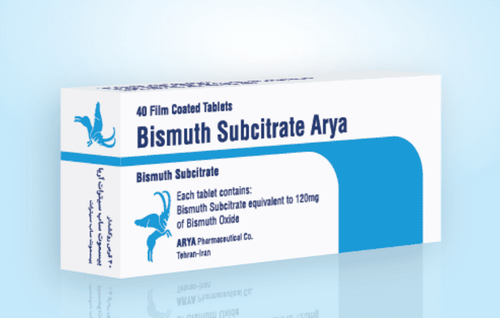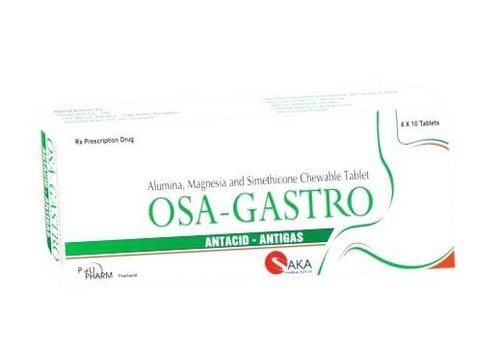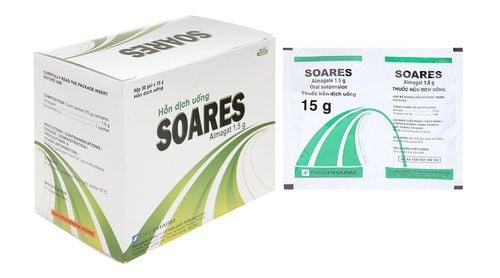This is an automatically translated article.
The drug Docusil or essentially Docusate is a stool softener. The drug's mechanism of action makes bowel movements smoother and bowel movements easier. Accordingly, Docusil is used to treat or prevent constipation, to help relieve pain or damage to the rectum caused by hard stools or straining during bowel movements. However, it is necessary to adhere to the indications and dosages on the drug label for the safe use of the drug.
1. What is Docusil?
Docusil contains docusate as an ingredient. This is a stool softener used to treat or prevent constipation in adults and pediatric patients.
Docusate was originally marketed as the dioctyl sulfosuccinate salt but the generic name was later shortened to the current version. Other salts of docusate, such as docusate sodium, docusate potassium, or docusate calcium, are also considered clinically and effectively interchangeable in the treatment of constipation. Mechanism of action of this therapy as a surfactant on the intestinal mucosa, enhancing the attraction of fat and water reverse osmosis through the intestinal wall and into the solid waste. As a result, the stool in the colon will be softer, the patient will be easier to defecate, both improving constipation and avoiding damage to the intestinal mucosa.
2. How to use Docusil?
Tablets or oral capsules are to be taken by mouth with a full glass of water and keep the tablet shape for best effect, without chewing, crushing or breaking the structure of the tablet. In contrast, with the dosage form is liquid or syrup, the way of use is also orally. This is the most common form for children. When administering medication to a child, a parent or caregiver should measure the exact dose as indicated on the label or as directed by a physician using a calibrated measuring device. The amount of medicine taken out should be mixed with 200ml of water, fruit juice or milk to reduce bitterness and prevent throat irritation.
For rectal dosage forms, the patient should lie on the left side, knees bent and arms relaxed. Alternatively, the patient may kneel, then bend the head and chest forward until the left side of the face rests on a surface with the arms comfortably folded. Open the Docusil vial by twisting and unscrewing the cap. The shaft of the tube can then be moistened with water or lubricated the anal area before insertion. Hold the tube in line with the axis of the rectal tube and at the same time squeeze the tube until the contents are empty. Maintain pressure to squeeze the tube until the tube is completely removed from the rectum. Squeeze the buttocks to cover the anus to prevent the medicine from leaking out. After that, the pelvis will have a defecation reflex and the patient can have a bowel movement.
3. Possible side effects when using Docusil?
Stool softeners such as Docusil or docusate rarely cause side effects. However, while taking Docusil, some patients sometimes also experience unpleasant symptoms such as cramps, abdominal cramps, poor appetite and loose stools. Throat irritation has also been reported after taking liquid preparations of docusate, especially if not properly diluted prior to administration. Similarly, rectal irritation may also occur with rectal preparations, if irritation or rash occurs around the anus, discontinue use.
In addition, rash R (unspecified) has also been reported with all dosage forms of docusate but incidence has not been determined.

Thuốc Docusil có thể gây tình trạng chán ăn cho người bệnh
4. Notes when using Docusil?
Before self-medicating with laxatives such as Docusil or docusate preparations in general, patients should consult a healthcare professional if they themselves notice a sudden change in bowel habits. convenient for two weeks. Also, patients should not use this product for longer than one week without consulting a healthcare provider.
Patients should also not use Docusil when they have both constipation, abdominal pain, nausea and vomiting. In addition, if Docusil fails to induce a bowel movement after administration or if gastrointestinal bleeding from the rectum occurs, patients should be instructed to discontinue laxatives in general and consult a physician. doctor opinion. Continued may indicate a serious condition, requiring specialized intervention.
If the rectal dosage form of Docusil is chosen, the patient should be encouraged to follow proper dosing techniques, as improper enema can lead to abrasions or damage to the rectal mucosa. . For patients with impaired rectal function, including chronic constipation and loss of sensation, a specialist rectal examination is necessary to be examined by a physician and given appropriate indications.
In summary, the drug Docusil contains docusate, a drug of the laxative group and is often indicated for the treatment of constipation. Although it is an over-the-counter drug, it should be used in accordance with the patient's condition, do not take docusate if there are signs of suspected intestinal obstruction as well as nausea, vomiting or severe stomach pain. . At the same time, in cases of suspected constipation due to pathology, it is necessary to proactively visit a doctor to receive active treatment from the beginning, avoid arbitrarily using Docusil for a long time without signs of improvement, which will lead to danger. for the patient.
Once you understand what Docusil does as well as the mechanism and how it works, you should pay attention during use so that the treatment is highly effective as well as limited side effects.
If you have questions or need advice, customers can share information and send questions to the website of Vinmec International General Hospital to be answered and consulted by qualified doctors.
Please dial HOTLINE for more information or register for an appointment HERE. Download MyVinmec app to make appointments faster and to manage your bookings easily.
Reference source: webmd.com - wellrx.com - drugs.com - cnyfamilycare.org












